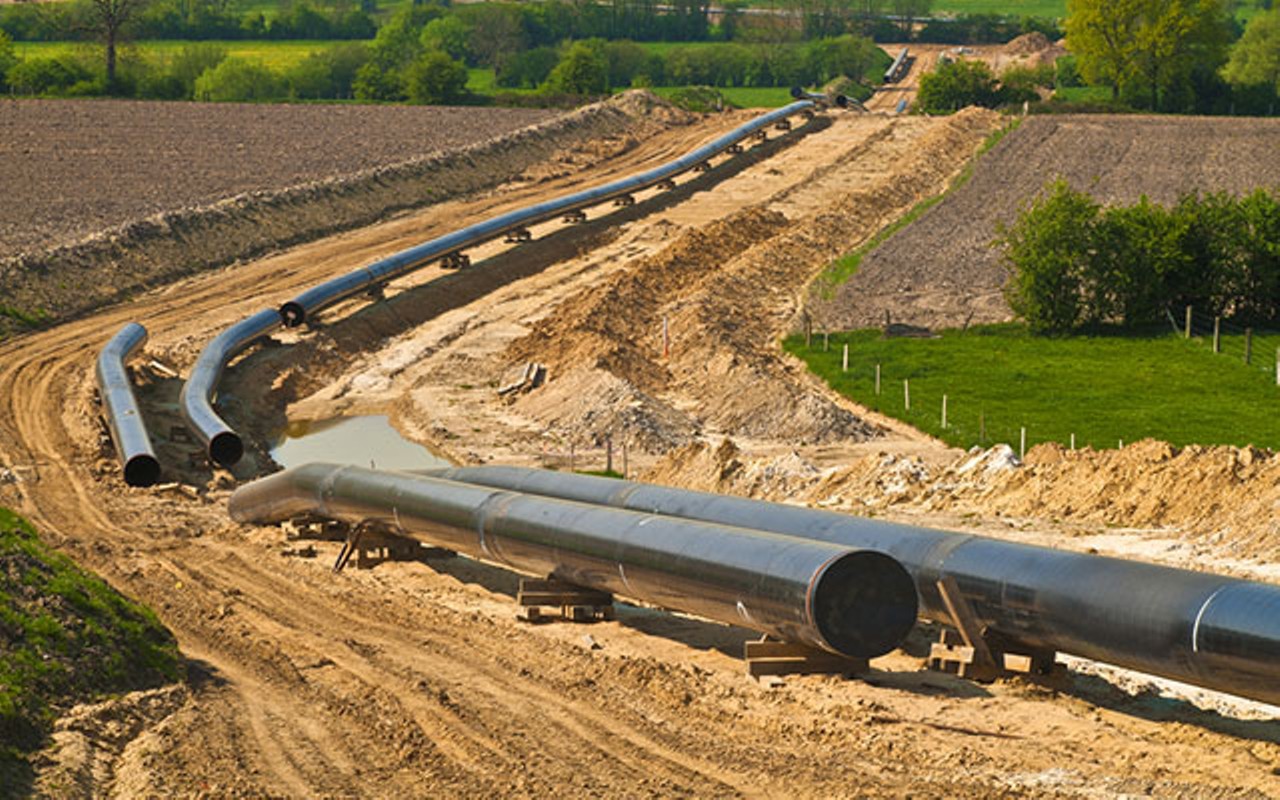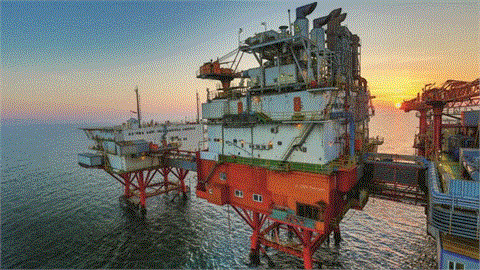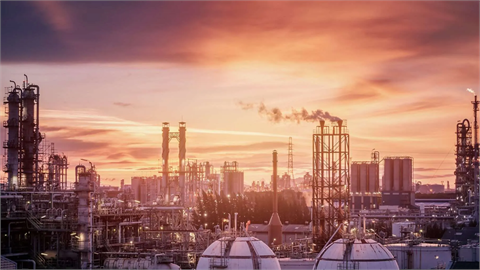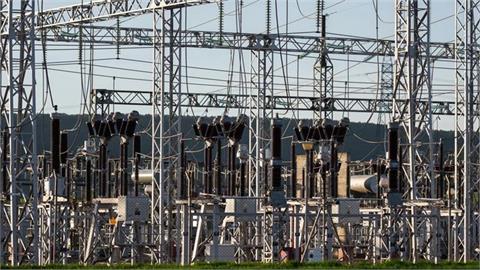On January 30, the deepwater drillshipSaipem 12000sent its drill bit into a cavern beneath one-and-a-quarter miles of water and a mile of rock in the eastern Mediterranean. The Italian oil and gas company Eni, which had contracted the ship, announced a week later that the cavern, called Calypso, was “an extended gas column,” containing an estimated six to eight trillion cubic feet of natural gas
On January 30, the deepwater drillshipSaipem 12000sent its drill bit into a cavern beneath one-and-a-quarter miles of water and a mile of rock in the eastern Mediterranean. The Italian oil and gas company Eni, which had contracted the ship, announced a week later that the cavern, called Calypso, was "an extended gas column,” containing an estimated six to eight trillion cubic feet of natural gas. The gas deposit lies under Cyprus’s exclusive economic zone—the area off a country’s coast where it has sovereign rights to exploit, manage, and conserve natural resources. Seismic studies suggest that the Calypso find is only a small fraction of the island’s future hydrocarbon wealth.
Meanwhile, ExxonMobil and the Qatar Petroleum Company are embarking on their own exploratory drilling off Cyprus’s southern shore in October. "We know the size of the structures and the possible hydrocarbons in them,” says geologist Konstantinos Nikolaou of the intended drill sites in an allotment called Block 10. "The sum of the deposits may amount to more than Zohr. . . . It is very promising,” he says.
At 30 trillion cubic feet, Zohr is the eastern Mediterranean’s largest known gas deposit, discovered three years ago offshore Egypt. Egypt plans to be energy self-sufficient by the end of 2018, doing away with $3 billion a year in oil and gas purchases. Similar deposits would make Cyprus not only self-sufficient, but an exporter.
Egypt and Cyprus are blessed with proximity to the petroleum-rich Eratosthenes Seamount, now almost half a mile below sea level. Eight million years ago it was an island surrounded by coral reefs. "These provided the biomatter that rotted and created the gas,” says Nikolaou.
These are just the latest in a spate of gas discoveries that are changing the strategic value of the eastern Mediterranean. The gas rush began in earnest in 2009 offshore Israel, which has to date found about 35 trillion cubic feet of gas—enough to power the country for a century at current rates of consumption.
This has satisfied a decades-long quest for energy security amid hostile neighbors—Israel now produces 60 percent of its electricity from its own gas—while also powering Israel’s regional diplomacy. It has already signed agreements to sell gas to Jordan and Lebanon, which previously relied on Egypt and Syria. Thanks to the speed with which it is attracting investment, Israel has eclipsed them as an exporter.
The United States Geological Survey estimates that the marine basin divided between Egypt, Cyprus, Israel, Lebanon, and Syria may ultimately yield 350 trillion cubic feet of gas and 3.5 billion barrels of oil. That’s enough to power the region for decades or the European Union for 20 years. It is this latter prospect—of exporting energy to a wealthy and strategically important region—that is creating a new commercial and diplomatic alignment in the region.
Birth of a pipeline
In the autumn of 2014, European Commissioner Maros Sefcovic, responsible for the European Union’s energy security, met with the energy ministers of Israel, Cyprus, Greece, and Italy in Rome. The subject of the meeting was an aspirational project: a 1,200-mile pipeline that would convey gas from Israel and Cyprus, via Greece and Italy, to the European market.
The pipeline, dubbed East Med, was the brainchild of Greek energy minister Yannis Maniatis. Greece’s Public Gas Corporation (DEPA) and Italy’s Edison had formed an alliance the previous summer to build it, but they needed E.U. support.
"The Israeli minister was due to speak before us,” says Maniatis, recalling the occasion. "And he suddenly launched a verbal assault on the commissioner and the other Europeans present, saying, ‘I don’t understand why you are not more actively promoting East Med, which will convey natural gas from my country and Cyprus. Don’t you want cheaper natural gas for your citizens?’ [Cypriot energy minister Yiorgos] Lakkotrypis and I looked at each other, thinking that Israel had just emerged as our strongest ally. We had prepared a little speech of our own, but we said nothing. We did not need to. Israel had just discovered Leviathan, so we were effectively being supported by the biggest gas supplier in the area.” Leviathan is the biggest of Israel’s gas fields, containing two-thirds of its known reserves.
Israel is a relative newcomer to hydrocarbons, but it is a pivotal player because its discoveries prompted the new explorations offshore Egypt and Cyprus. After a string of Israeli discoveries in 2009-11, Egypt put up 15 offshore exploration zones for tender. And it was an American company operating in Israel, Noble Energy, that discovered Cyprus’s first offshore gas field, Aphrodite, in 2011.
Suddenly having found more gas reserves than they could use domestically, Israel, Cyprus, Greece, and Italy proposed creating a physical and diplomatic umbilical cord of sorts, to pump the East Med gas to the E.U. The proposal could not have been more timely, because Europe’s main source, North Sea gas, is beginning to dwindle, and Europe had just rediscovered the dangers of reliance on Russia.
Russia’s long reach
In January 2009, the political tensions between East and West came to a head over Ukraine, which was then seeking closer ties to the E.U. and the West. Ukraine’s and Russia’s state gas monopolies, Naftogaz Ukrainy and Gazprom, played a game of brinkmanship over Naftogaz’s payments for gas deliveries. On January 7, Gazprom shut off supplies to Ukraine for a fortnight.
The E.U. relies on Russia for a third of its gas, and Ukraine is one of two transit countries for pipelines carrying Russian supplies. A complete cutoff had never happened since the building of the pipeline system in Soviet times, and it caught Europe unprepared. Domestic production and deep reserves kept western Europe warm; but southeast Europe, lacking infrastructure and entirely reliant on Russian gas, suffered industrial shutdowns and frozen homes.
The Ukraine crisis was a turning point in E.U.-Russia relations. The European Commission sought to punish Gazprom for abusing its dominant position in the gas market. In 2015, a three-year investigation found that Gazprom had contravened the E.U.’s free movement of goods policy by prohibiting member states from reselling surplus gas to each other. Gazprom was forced to renegotiate its contracts. Gazprom was also accused of making exports to Bulgaria and Poland conditional on their allowing new pipelines to be built across their territories. The E.U.’s actions against Gazprom effectively killed the South Stream pipeline, which would have carried Russian gas across the Black Sea to Bulgaria.
The supply disruptions of 2009 and the subsequent cancellation of Russian pipelines refocused E.U. efforts on creating a so-called Southern Corridor to transport gas to Europe from the Shah Deniz field of Azerbaijan, through Turkey and Greece. Sponsored by a consortium of European oil giants, the Trans Adriatic Pipeline, or TAP, has now nearly completed a pipeline that will carry gas across northern Greece to Italy, while a Turkish-Azeri consortium is completing the Trans-Anatolian pipeline across Turkey that will connect with TAP. The gas is on schedule to start flowing in 2020.
But Russia, which still supplies about 35 percent of E.U. gas, is proving hard to sideline. "Now gas production from Shah Deniz I has fallen, and no one knows whether Shah Deniz II will produce enough to make up the shortfall in its initial phase,” says Kostis Stambolis, executive director of the Institute for Energy for Southeast Europe. "The result is that TAP is now in advanced discussions with the Russians about taking gas that the Russians want to send to Europe. . . . So the whole European narrative about differentiating its gas supply—which was the point of the Southern Corridor—goes out the window.”
Russia has meanwhile relaunched its canceled pipeline across the Black Sea under the name TurkStream and is building it to Istanbul instead of Bulgaria. A sister pipeline, TurkStream 2, is in the offing. DEPA and Edison may now revive the idea of a second pipeline from Turkey to Italy, via Greece, to complete the journey of TurkStream gas to Western Europe. Events seem to be vindicating the Russians.
"The vision was always that there will be enough gas discovered proximate to a corridor of three pipelines coming through Turkey, and that would constitute a supply counterweight to Russian gas, and would happen by 2020,” says Jonathan Stern, distinguished research fellow at the Oxford Institute for Energy Studies. Since that E.U. vision arose, however, Russia and Turkey have become close allies in Syria. Russia now supplies two-thirds of Turkey’s gas and is building Turkey’s first nuclear reactor.
Stern believes the Russian-Turkish energy alliance is going to prove durable, because it is based on hard-won experience in the region. "The Russians are very effective at making pipelines happen, and the Turks have found in this massive negotiation with everybody—the Iranians, the Iraqis, the Turkmens . . . —that you can negotiate with everyone, but the only ones who are going to deliver are the Russians. Russians have got the gas, the finance, the partners, and the desire to get these pipelines done, and everyone else are basically time wasters.”
The four countries backing East Med are thus hoping to take advantage of waning European enthusiasm for Turkey as an alternative to Russian gas. In their proposition, the next major leg of the Southern Corridor would be entirely E.U.-owned and would source its gas in or near the E.U. "I’m not going to say [officials in Brussels] have given up on Turkey as a transit route, but they’re less enthusiastic,” says Stern. "They’re kind of caught between not wanting to take Russian gas and saying, ‘If we’ve got to take Russian gas . . . then we’d rather take it through an E.U. country where we have more control.’ ”
Commerce versus geopolitics
Not everyone is convinced that bringing East Med gas to the E.U. is viable in purely commercial terms. "Unless considerable additional quantities of gas are found in the eastern Mediterranean . . . I don’t think that this pipeline is commercially feasible,” says Sir Michael Leigh, who runs a program on the implications of eastern Mediterranean gas discoveries at the German Marshall Fund.
Gina Cohen, a university lecturer and consultant in the East Med gas market, agrees. "Such a pipeline between Israel and Italy would be 2,000 kilometers long and would have to be laid in extreme depths of over 3,000 meters of water, especially between Crete and mainland Greece. The project would need to have four landfalls and at least three compressors, all adding to complexity and costs.”
Cohen estimates the pipeline’s cost at $10 billion, which would put Mediterranean gas at a higher retail price than Gazprom’s. "For the project to be viable, the E.U. would have to provide billions of dollars of subsidies,” she says.
Key players, however, see those subsidies as legitimate. "It’s not enough to see [East Med] as a commercial project that will sell at prices comparable to Gazprom,” says Mathios Rigas, who formed Energean in 2007 for the express purpose of extracting Eastern Mediterranean gas. The Russian state monopoly "is producing on land using existing infrastructure,” he explains. "Someone starting out now at depths of two to three kilometers will never be able to compete with that.”
Instead, he sees East Med very much like the interstate highway system—an "entirely necessary” public-private investment that causes private enterprise to spring up alongside it. "The installation of pipelines allows companies like ours to seek opportunities,” he says. Energean is building the eastern Mediterranean’s only floating production, storage, and offloading platform as part of a massive investment in two large Israeli gas fields, Karish and Tanin. But it has also, in an Israeli bidding process, won the right to explore five smaller blocks, which remain unconnected to any infrastructure and together could contain about 5 trillion cubic feet of gas. "They may be smaller [than the major Israeli fields], but the new infrastructure would allow these structures to be commercially viable.”
The head of Greece’s exploration licensing body, Hellenic Hydrocarbon Resources Management, believes that an E.U. subsidy will be an easy sell given the pipeline’s political importance. "We’ll raise the price of gas a few cents, and we won’t even feel it. That’s how it’ll work. That’s how it always works,” says Yannis Bassias.
The E.U. seems to be seriously considering the project. In 2013 it listed East Med as a Project of Common Interest, one possibly worthy of E.U. funding. Two years later, it put two million euros into a pre-flow study, and this year approved 34.5 million euros to help draft a detailed marine survey of the route the pipeline would follow on the seafloor and an engineering design study.
DEPA, which has drafted the only existing feasibility study, insists that "East Med is technically viable, commercially competitive, and economically feasible,” although it won’t say at what gas price these things hold true. Kostas Karayannakos, its executive director of gas supply, considers it "slightly more attractive” than piping the gas through Turkey or liquefying and shipping it.
The key attraction of East Med is stability. It would be a risk-free, intra-E.U. route carrying committed volumes of gas to Europe for a quarter-century. Europe would in turn be a reliable client, in contrast to cash-poor regional economies. "We used to seek out investors in East Med. Now they are seeking us out,” Karayannakos says.
For Karayannakos, the pipeline brings tremendous geopolitical advantages, rendering Greece "the E.U.’s ‘bridge’ to the important resources of the Levantine while it is already Europe’s ‘gateway’ for Caspian gas,” making Greece "an integral part of Europe’s energy security chain” and "ending the isolation of Cyprus.” The combined flows of TAP and East Med would make Greece the conveyor of 6 percent of the gas the E.U. consumes.
Turkey’s reaction
It is precisely this vision—of a pipeline that circumvents its exclusive economic zone, turns Cypriot energy interests into European energy interests, elevates the importance of Greece in the E.U., and offers Greece and Cyprus a leading role in the E.U.’s relations with the Middle East—that concerns Turkey. Its displeasure has already caused one high-seas standoff.
On February 9, shortly after discovering Calypso, theSaipem 12000drillship homed in on a body of water east of Cyprus known as Block 3, where Eni also has exploration rights. Its intention was to bore a hole into a deposit known as the Cuttlefish prospect. It never reached its intended coordinates. Five Turkish navy frigates blocked its path. The drillship trod water until February 23, when it attempted to circumnavigate the blockade. One of the frigates threatened to ram it. The drillship turned and sailed for Morocco. During the same period, a Turkish coast guard vessel rammed a Greek one in the Aegean—an unprecedented event many analysts attribute to the discovery of Calypso.
Since the discovery of Calypso, "alarm bells have been going off in Turkey, and officials have been saying, ‘the Greeks are going to take advantage of this situation,’ ” says Angelos Syrigos, associate professor of international law and foreign policy at Panteion University in Athens. "Turkey has made a big investment since 2000 in becoming the basic conveyor of gas to Europe, and to a great extent it has succeeded. . . . The discovery of new deposits in the Eastern Mediterranean threatens this position. . . . But [Turkey’s] main concern—and where it faces a strategic threat—is that [the energy deposits] could alter the given situation in Cyprus ahead of a solution” to reunify the island.
Two decades of talks have so far failed to reunify Cyprus, divided by a Turkish invasion in 1974. A Greek attempt to overthrow the government in Nicosia that year led Turkey to believe that the island’s union with Greece was imminent and that under such an arrangement Turkish-Cypriots would have no guarantee of political equality. Since then, Turkey has maintained an occupying force of almost 40,000 troops on the island and supplanted much of the original Turkish-Cypriot population with settlers from the mainland who are more sympathetic to Ankara’s vision of maintaining strategic depth in the Mediterranean. The Turkish Republic of Northern Cyprus, proclaimed in 1983, remains an internationally unrecognized entity, and the ongoing occupation isolates Turkey diplomatically.
The Cypriot government says it will share its mineral wealth with the Turkish-Cypriots in the north after a reunification deal is struck. Concerned that this increases Cypriot leverage, Turkey insists on the wealth being shared now. To press the point home, Turkey has announced that it will send its government-owned drillship, theBarbaros Hayreddin Pasa, to explore for gas in Cyprus’s exclusive economic zone.
Turkey is something of an exception in the region. Egypt, Israel, and Cyprus defined their exclusive economic zones early this century. They ratified these bilateral agreements, sold concessions to major oil companies, and found gas. Israel and Egypt are already extracting it.
Turkey is the only country in the eastern Mediterranean that has so far found no proven and probable resources even though, in Syrigos’s estimate, it has spent at least $560 million on acquiring two seismographic research vessels and a drillship. It is also the only country that hasn’t defined its exclusive economic zone with neighbors, and disputes theirs. In 2004, Turkey suggested drawing a line midway between its coast and Egypt’s, riding roughshod over the rights of the countries in between. Egypt politely refused.
In 2011, Turkey agreed on an exclusive economic zone (EEZ) with the Turkish Republic of Northern Cyprus. The zone claimed by the TRNC sits almost exactly on top of the zone the Republic of Cyprus had already settled on with its neighbors to the east. The zone claimed by Turkey sits on top of much of the zone Cyprus has agreed on with Egypt to the south. On the same day this agreement was signed, the TRNC signed over the rights in its zone to the Turkish state petroleum company, thus pitting Cyprus directly against Turkey in virtually all its hydrocarbon explorations.
"Turkey’s problem is that it sees that it has been left out of the bonanza, because all the interesting areas lie outside its territorial waters and EEZ,” says energy expert Stambolis. "It’s trying to create problems for Cyprus because its only hope is to take something from Cyprus. . . . So it’s very irritable right now.”
The Southern Corridor is bound to give both Greece and Turkey added importance to the European Union, and that creates a common interest; but in Cyprus their interests clash, and it will be up to their allies to help bridge differences. Regional governments are pushing for East Med, and the size of deposits may eventually advocate in its favor. This makes East Med a political as much as a commercial project. "If the E.U. and the four governments [Israel, Cyprus, Greece, Italy] are aligned behind it, it can find financing,” says Energean’s Rigas. "There will be more discoveries in the region. We’re still at the beginning.”
By John
Psaropoulos / www.weeklystandard.com




